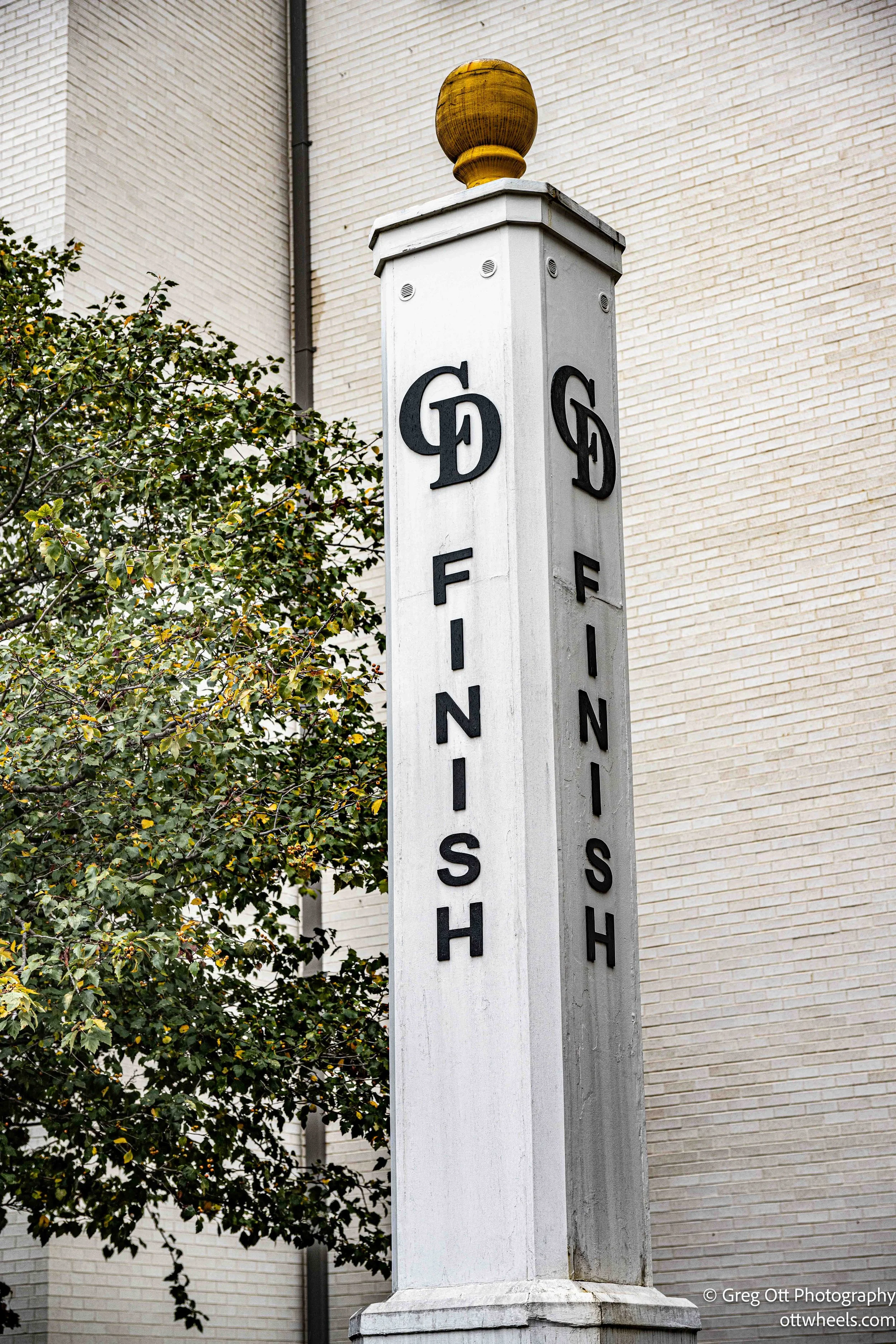Louisville Slugger, Church Hill Downs, NULU
I stayed overnight at Knobs State Forest Parking lot. It was pretty close to the interstate but the trees helped muffle the noise. During the night I heard two cars drive but, apparently there are a couple remote houses at the end of the forest.
I was an hour from Louisville and left a little before 8 a.m.
I got to the Louisville Slugger Museum & Factory about an hour before it opened, so I went looking for coffee and found a small café called Black Beard Coffee just a few blocks away. The place had an easy, comfortable vibe—warm wood tables, soft music, and the smell of espresso drifting out the door. The woman behind the counter greeted me like a regular. As she made my drink, we started talking about what to see around Louisville. She recommended the Speed Art Museum, which she used to work at before switching to coffee. “It’s one of the best museums in the state,” she said. “Even if you’re not into art, the building alone is worth it.”
Curious, I asked how the café got its name. She smiled and said the owner had once visited the Outer Banks of North Carolina and became fascinated with the legend of Blackbeard the pirate. The name just stuck. I told her I’d been to another Black Beard Café in Greenville, North Carolina, and even visited Bath, where Blackbeard supposedly lived—one of several towns that claim him. We laughed about how every coastal town wants to own a piece of the myth.
The coffee was smooth and bold, exactly what I needed after a restless night. I sat by the window, watching Main Street slowly come to life. By the time I finished, the museum was opening, and I walked back toward the building with the 120-foot bat leaning against its front—an unmistakable Louisville landmark.
Louisville Slugger Museum & Factory
Inside, the scent of wood hit me immediately—a mix of sawdust, maple, and ash. The tour began with a short film about the Hillerich & Bradsby Company, the family-owned business that has been crafting Louisville Slugger bats since the late 1800s. When we stepped onto the factory floor, I was struck by how seamlessly tradition and technology coexist. Almost all the wood used for the bats—ash and maple—comes from the Pennsylvania–New York border region, the only place in the world where the growing conditions produce the perfect density and straight grain for professional bats. Rows of billets stood stacked neatly, waiting their turn on two massive CNC machines imported from Italy, which can carve a flawless bat in seconds. It’s remarkable how much precision and care goes into something that, to most of us, just looks like a stick of wood.
After the factory, I toured the museum, which turned out to be just as captivating. Near the entrance, there’s a wall of small wooden plaques engraved with the names of every player who’s ever signed a contract with Hillerich & Bradsby—a quiet monument to baseball’s lineage. One exhibit that caught my attention was the original bat Bud Hillerich made for Pete Browning in 1884. Browning, a local star, was nicknamed the Louisville Slugger, and when Bud’s handmade bat helped him break a slump, the nickname stuck—not just to the player, but to the bat itself. That’s how the world’s most famous bat brand was born.
The museum also displays Joe DiMaggio’s bat from his 56-game hitting streak, the original Pete Browning bat, and tributes to legends like Jackie Robinson and Roberto Clemente. I stopped at Robinson’s quote engraved on the wall:
“A life is not important except in the impact it has on other lives.”
It’s hard not to pause there a moment, surrounded by so much history tied to something as simple as wood and sweat.
The story of Hillerich & Bradsby is a classic piece of American craftsmanship. J. Frederick Hillerich, a German immigrant, opened a woodworking shop in Louisville in the 1850s, making everything from butter churns to bedposts. His son Bud, an avid baseball fan, saw opportunity in the game that was sweeping the nation. When Pete Browning broke his bat during a slump, Bud turned him a new one from a piece of white ash. Browning’s next game was a breakout performance, and soon word spread across the baseball world. Players started asking for bats made by “the Louisville Slugger.” Years later, Frank Bradsby joined the company, helping to expand production and marketing into a full-scale business that still operates from the same city today.
At the end of the tour, they handed everyone a small souvenir bat—polished, smooth, and smelling faintly of fresh-cut wood. I walked back outside into the warm afternoon light, past the giant steel bat leaning against the brick façade. Standing there, it was easy to see how something so simple could become so iconic. Baseball might not mean the same thing to everyone, but that mix of craft, history, and nostalgia has a way of connecting people—one swing at a time.
It was raining as I left the Louisville Slugger factory. I stopped at the coffee shop down the street again for a coffee and then proceeded to the van. I was surprised how many people were walking the streets without an umbrella or rain jacket. I headed to Church Hill Down avoiding the highways. Passing through the Univeristy of Louisville I had to wait 10 minutes for a freight train. Cars were turning around not willing to wait for the end of the train.
Church Hill Downs
The wind had picked up and the rain was coming in at an angle now. I parked away from the main group of cars and trucks and got a little extra exercise.
Touring Churchill Downs was one of those experiences that felt both historic and alive at the same time. The moment I walked into the museum, it was clear this wasn’t just about horse racing—it was about a century and a half of Kentucky pride. The exhibits were laid out beautifully, guiding you through the evolution of the Derby from its earliest days in 1875 to the modern spectacle it’s become. There were elegant dresses, old jockey silks, vintage trophies, and even a few retired horseshoes that looked like they’d carried legends. A short film in the 360-degree theater pulled it all together. The sound of hooves, the roar of the crowd, and the sight of horses thundering down the final stretch was surprisingly moving—even if you weren’t a racing fan when you walked in, you’d probably leave as one.
After the film, I joined a guided tour of the grounds. Standing trackside where the Kentucky Derby is run each May was something special. You could almost feel the energy that must surge through the stands when 150,000 people shout as one. The guide pointed out the twin spires—those iconic peaks that define the Churchill Downs skyline—and shared stories about the jockeys, trainers, and owners who’ve made their mark over the years. One of the most interesting displays showed which gate positions had produced the most winners since records began. One gate, near the middle, was the clear favorite over the years, while another had never produced a single Derby champion. It was fascinating to see how even a few feet left or right at the start could make all the difference in racing history.
On the upper floor, the focus shifted to the sport’s biggest star—Secretariat. He wasn’t just a great racehorse; he was a phenomenon. In 1973, he won the Triple Crown and set records that still stand today. The exhibits dove deep into what made him extraordinary, including the autopsy results that revealed his heart weighed nearly 22 pounds—more than twice the average size of a thoroughbred’s. That massive heart, both literally and figuratively, powered him to victories no other horse has matched. The display also mentioned that every horse in the most recent Kentucky Derby traced its lineage back to Secretariat. It was a powerful reminder that his legacy isn’t just in the past—it’s still thundering down the track every spring.
After the tour, I stopped at the restaurant on site and ordered a huge cheeseburger. It was juicy, perfectly cooked, and surprisingly good for a museum café—though I’d pay for that decision later. Still, it was worth it. As I ate, I looked around at photos on the walls showing famous faces who’ve been part of the Derby over the years—celebrities, athletes, and even a few presidents. The Kentucky Derby has always been as much about the people as the horses. From Queen Elizabeth II to Muhammad Ali, from Tom Brady to countless country music stars, the list of names that have attended reads like an American who’s-who. By the time I left, I understood why they all come here. Churchill Downs isn’t just a racetrack—it’s a piece of living history.
Original Church Hill Downs Finishing Pole
NULU Louisville
I wasn’t ready to call it a day. There were still a couple of hours of sunlight left, even if the sky couldn’t decide what it wanted to do. I drove a few miles north to the NULU district—short for New Louisville—an area that’s become one of the city’s most talked-about neighborhoods. What used to be a stretch of run-down warehouses and forgotten storefronts has turned into a lively mix of art, food, and creativity. Old brick buildings now hold boutique shops, vintage stores, and small galleries that spill light and color onto the wet sidewalks. Even with the drizzle, people were still out walking, darting in and out of the shops. The air had that clean, rain-on-pavement smell that somehow made the neon signs and murals pop even more.
The food and coffee scene is what really defines NULU. Every block offers something new—modern Southern restaurants, small-batch ice cream shops, and cafés that clearly take pride in what they serve. I stepped into one of them to warmup and ordered a late coffee and a snack. It was warm and inviting inside, with soft lighting and views to the street. People were talking quietly, laptops open, a few sketching or reading. It had that creative, unhurried feel that comes when a neighborhood finds its rhythm. After spending the morning immersed in the tradition and history of the Louisville Slugger and Churchill Downs, ending the day here—in a space that represents Louisville’s new energy—felt like the perfect contrast.
I drove in the direction of Frankfort to a trailhead in a conservation area. The information I had was incorrect and there were sign indicating no overnight parking. As I left the park, a rainbow formed to my left.










































